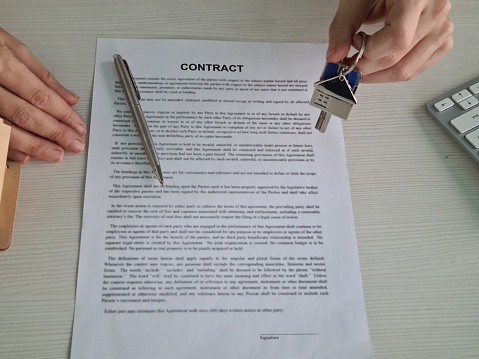
Investing in real estate can be a powerful way to create financial stability through passive(ish) income. Real estate offers a relatively reliable source of return on investment; over the long term, the right investments perform well. Real estate isn’t ideal for someone looking to make money quickly. If you want to invest in the real estate market, you’ll need to be prepared to set funds aside that you won’t be able to access quickly. Liquidating real estate assets can take time, so never invest money you’ll need back quickly.
Step 1: Choose one type of real estate investment to start
There are numerous ways to invest in real estate depending on the level of financial and active commitment you’re ready to make. Before investing in real estate, you’ll need to choose which area interests you the most.
- REIT: If you don’t want to manage properties and tenants or deal with any physical aspect of real estate investment, you could invest in REITs. An REIT, or Real Estate Investment Trust, allows you to invest in real estate without owning a physical property. REIT ETFs will enable you to invest in a portfolio of REITs. The benefit of these real estate options is that they have a lower entry cost and don’t require additional work on your end. REITs are a good option if you’re looking to diversify your investment portfolio or want a hands-off experience.
- Rental: properties: One of the more well-known forms of real estate investment is renting out residential homes to tenants. Typically, investors purchase single-family or multi-family properties and lease them to families or individuals. Residential properties have a higher entry cost and require substantially more hands-on work. While you could hire a property management company to handle tenants and repairs, it’s an expense you’ll need to factor into your plan. * Note: Purchasing your home can be considered an investment in real estate, especially if you can secure a low interest rate and make your monthly payments on time. Regular payments and low-interest rates will help you build equity in your home.
- Flipping properties: Unlike rentals, investors who purchase homes intending to flip spend a few weeks remodeling and repairing a property before selling it for a profit. This type of investment has become more well-known thanks to popular TV shows like Flip or Flop and Property Brothers. The entry investment on this can vary, especially if you purchase properties in bad condition. However, you’ll need to put in the work to make improvements to the properties to see a return on your investment.
- Commercial real estate: Some investors choose to work with commercial properties, like shopping centers, apartment complexes, restaurants, and office buildings. Commercial real estate can be a very profitable investment. Still, it has a higher entry floor, and it can be more volatile with economic shifts on the local and federal levels. Commercial tenants tend to require less attention than residential, but you’ll still have to manage repairs and collect payments.
Step 2: Research the numbers

Once you’ve narrowed down the type of real estate investment you’re interested in, take time to look at multiple options in your chosen specialty. This is the time to get a basic understanding of what the market looks like and create an outlook for the potential of your investment. You’ll want to consider things like the current real estate market (sales prices, rental prices, renter trends, current or future legislation that could affect your area, etc.). If you opt for a REIT, you may not need to do as much work in this area. But, you should understand some of the following to better calculate how your investment performs.
If you don’t like math, you won’t be a fan of this step, but it’s essential that you take the time to understand at least some of the numbers if you want to make money from real estate.
For example, if you don’t have a history of managing investment properties, you’ll need to qualify for special financing to purchase a rental home. You’ll need to pay for rent loss insurance coverage, and you’ll need to factor in tax ramifications for negative rental income. A few numbers you should consider include:
- Price to income ratio: Look at the median household price in the area you want to invest in. Compare the rates over a decade to understand how the market fluctuates.
- Price-to-rent ratio: Similar to the price-to-income ratio, you’ll want to compare median home prices with median rents in your target market. You can figure this out by dividing the median house price by the median annual rent. Numbers lower than 15 mean it’s a better market for renters, above 20, and it’s a better market for buyers.
- Gross Rental Yield: If you’re purchasing residential or commercial property, you’ll want to use this number to determine how much you could earn from your investment. To figure out this number, divide the Gross Annual Rent (the amount of rent you’ll charge over a year) by the current market value of a home. Multiple that number by 100 to get a percentage. That number is the percentage of return you would get before expenses.
- Capitalization Rate: The capitalization rate provides more information than the gross rental yield because it includes operating expenses. This allows you to get a more accurate view of potential earnings. To get this number, take the annual rent and subtract expenses. Divide that number by the property cost and multiply by 100. You should include maintenance costs, insurance, vacancy, and miscellaneous expenses.
Step 3: Create a plan

Once you understand your area’s market and know where you want to put your money, you’re ready to put together a detailed investment plan. If you need to secure financing (next step), you’ll especially want to ensure you have a clear, professional plan. Your plan should include whether you plan to work in a group or on your own, as well as expected costs, projected revenue, and estimated return on investment. If you’ve researched your numbers and figured out your capitalization rate and price-to-income ratios, this should be easier to fill out.
If you want to work with multiple people, outline each person’s roles, responsibilities, and investments. This plan can help resolve any communication or expectation issues that could arise in the future. It can also help you appear as a more attractive customer to lenders. Approaching a lender with a clear plan and proof that you understand what you’re getting into can make a difference in whether you’re approved for funding or not.
During this stage, you should identify two or three properties you want to invest in (if you’re not going the REIT route).
Investors opting for a REIT or REIT-ETF won’t likely need to create a more detailed plan. You’ll also be able to avoid financing if you start with smaller investments. However, you should have a plan for how often you want to check your REITs and key points where you might consider selling or reinvesting.
Step 4: Secure financing

Investment loans are similar to typical mortgage loans but may have additional requirements. For example, don’t be surprised if your lender asks for a 15% or more downpayment. You’ll also need a higher credit score than if you were purchasing a primary residence. Some borrowers try to get around the additional rules by claiming a second home purchase and using it as a rental property, but lenders often have rules in their loans about this practice. You should talk to your lender about this option to see if you can save money or if your loan has limitations.
Investors could opt for a traditional loan (conforming, jumbo, or government-backed loan (like FHA). Alternatively, some investors opt for different investment options like a home equity loan on their primary residence, a private loan, seller financing (typically works best with flipping properties), or hard-money loans.
Research all your options and determine which one provides the most financing for the lowest cost. Since your goal is to profit from your investment, saving even a few percentage points on your loan could make a huge difference.
Step 5: Maintain your investment

Once you’ve secured funding and purchased your first property (or REIT), it’s time to go into maintenance mode. This mode will look different based on the type of investment you choose. Investors opting for a REIT can expect quarterly and annual statements. At the very least, REIT investors should review their annual statements. If you want to be more involved, keep up to date with your account when significant changes are announced to investors or via quarterly reports. It’s usually not necessary to check the status of your account daily or weekly.
Investors opting for physical real estate investment have more work ahead. Flippers should have a detailed plan for a timeline to maximize their savings, and you’ll want to stick to that plan as closely as possible. If you’re going to lease, you must clean up the property and rent it out as quickly as possible. If you don’t want to do it yourself, you may need to find a property management company to handle rent, maintenance, and other duties.
Real estate offers a variety of investment opportunities. Investors should take the time to understand the market to take advantage of low purchase prices and maximize their savings. Since real estate investments tie up funds for long periods, it’s essential that you research and choose an investment strategy you’re comfortable seeing through for the long term.
Take This Retirement Quiz To Get Matched With An Advisor Now (Sponsored)
Are you ready for retirement? Planning for retirement can be overwhelming, that’s why it could be a good idea to speak to a fiduciary financial advisor about your goals today.
Start by taking this retirement quiz right here from SmartAsset that will match you with up to 3 financial advisors that serve your area and beyond in 5 minutes. Smart Asset is now matching over 50,000 people a month.
Click here now to get started.
Thank you for reading! Have some feedback for us?
Contact the 24/7 Wall St. editorial team.



